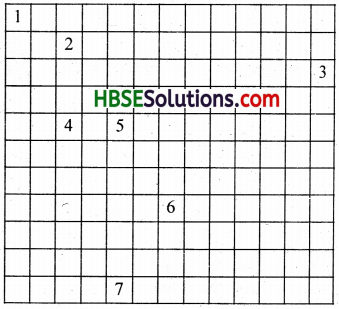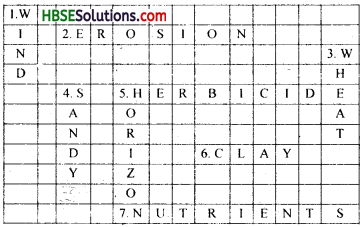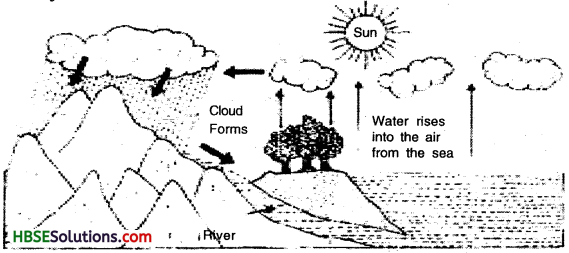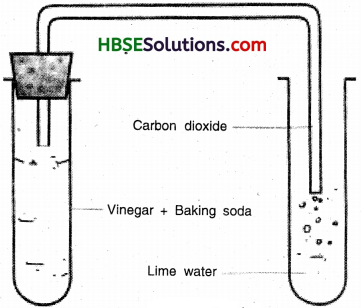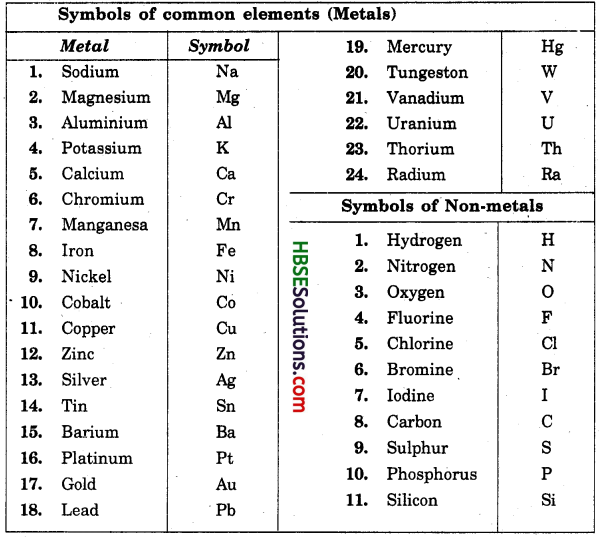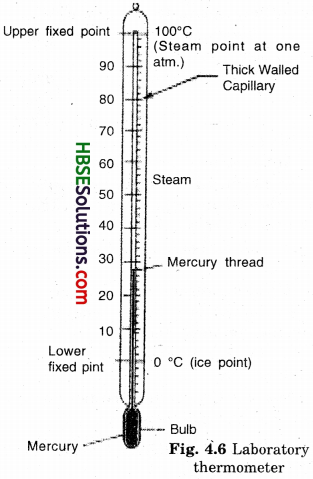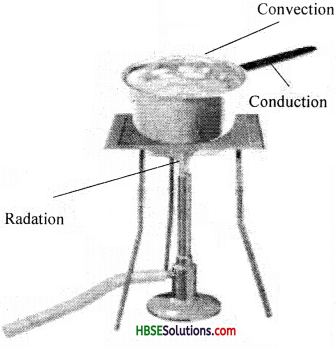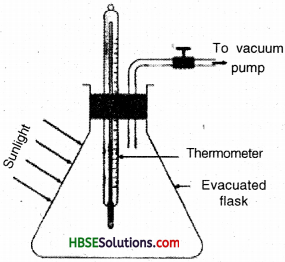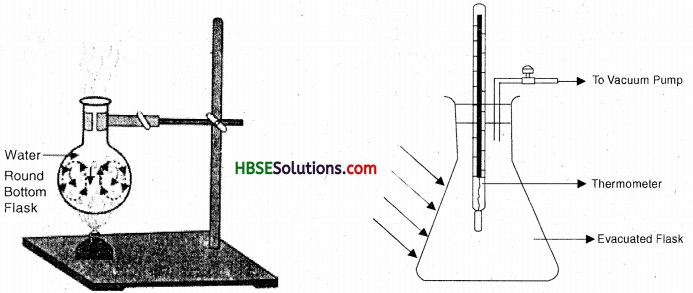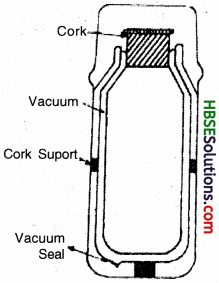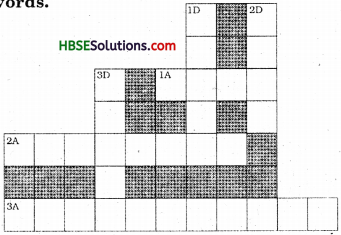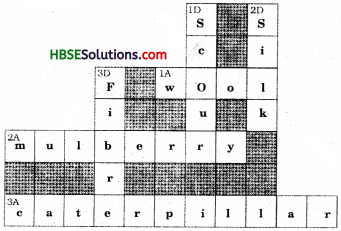HBSE 8th Class Science Solutions Chapter 3 Synthetic Fibres and Plastics
Haryana State Board HBSE 8th Class Science Solutions Chapter 3 Synthetic Fibres and Plastics Textbook Exercise Questions and Answers.
Haryana Board 8th Class Science Solutions Chapter 3 Synthetic Fibres and Plastics
HBSE 8th Class Science Synthetic Fibres and Plastics Textbook Questions and Answers
Question 1.
Explain why some fibres are called synthetic?
Answer:
Some fibres are called synthetic because they do not occur naturally and are made by man using petrochemicals.
Question 2.
Mark (✓) the correct answer:
Rayon is different from synthetic fibre because
(i) it has a silk like appearance
(ii) it is obtained from wood pulp
(iii) its fibres can also be woven like those of natural fibres.
Answer:
(ii) it is obtained from wood pulp. ✓
Question 3.
Fill in the blank with appropriate words:
(i) Synthetic fibres are also called ……………. or ……………. fibres.
(ii) Synthetic fibres are synthesised from raw material called ……………. .
(iii) Like synthetic fibres, plastic is also a ……………. .
Answer:
(i) man-made or artificial fibres
(ii) petrochemicals
(iii) polymer.
![]()
Question 4.
Give examples which indicate that nylon fibres are very strong.
Answer:
Nylon fibres are very strong, thus they are used to prepare ropes for mountaineering. They are also used to prepare parachutes.
Question 5.
Explain why plastic containers are favoured for storing food.
Answer:
Advantanges of storing foods in plastic containers are:
(a) the plastics do not react with the food stored in them.
(b) the plastics are light weight and are strong.
(c) they are easy to handle and safe.
Question 6.
Explain the difference between the thermoplastic and thermosetting plastics.
Answer:
Differences between thermoplastic and thermosetting plastics:
(i) Thermoplastics can be mtelted on heating but thermosetting plastics Cannot be melted.
(ii) Thermoplastics can be reshaped as many times as desired but thermosetting plastics cannot.
(iii) Thermoplastics can be bent but thermosetting plastics cannot be bent.
(iv) Thermoplastics are good conductors of heat, thermosetting plastics are bad conductors of heat.
Question 7.
Explain why the following are made of thermosetting plastics:
(a) Saucepan handles
(b) Electric plugs/switches/plug boards.
Answer:
(a) The handles of saucepan are made of thermosetting plastic because it is a bad conductor of heat and do not get heated up while cooking. So it becomes easy to handle the utensil while cooking.
(b) Electric plugs/ switches and plug boards are made up of thermosetting plastic because it is a bad conductor of electricity. It does not allow the electric current to pass through it, thus safe in using in electric appliances.
Question 8.
Categorise the materials of the following products into ‘can be recycled’ and ‘cannot be recycled’.
Telephone instruments, toys, cooker handles, carry bags, ball point pens, plastic bowls, electric wire covering, plastic chairs, electrical switches.
Answer:
Can be Recycled: Toys, carry bags, plastic bowls, ball point pen, plastic chairs, electric wire covering.
Cannot be Recycled: Cooker handles, electric switches, telephone instruments.
Question 9.
Rana wants to buy shirts for summer. Should he buy cotton shirts or shirts made from synthetic material? Advise Rana, giving your reason.
Answer:
Cotton clothes are preferred to synthetic clothes in summers because cotton is a bad conductor of heat. It does not allow the outer heat to enter in our body, thus protects body from heat. It also has more capacity to hold moisture than the synthetic clothes. So, it retains
the sweat of the body and keeps it cool. So, Rana should buy shirts made upof cotton.
Question 10.
Give examples to show that plastics are noncorrosive in nature?
Answer:
Following examples show that plastics are non-corrosive in nature:
(i) They are used to store chemicals in laboratories.
(ii) They are used to store all types of food, as it does not react to materials stored in it.
(iii) It does not even react with air and water.
![]()
Question 11.
Should theiiandle and bristles of a tooth brush be made of the same material? Explain your answer.
Answer:
No, the handle and bristles of a tooth brush should not be made of the same material because the bristles should be soft and the handle should be hard. So the bristles should be made up of soft material so that it does not harm the gums. The handles should be made up of hard material so that it can give firm grip.
Question 12.
‘Avoid plastics as far as possible,’ Comments on this advice.
Answer:
Plastics are harmful for our environment. Some of the plastics cannot be recycled, so they cannot be used again and thus cannot be finally disposed off. They thus, should be avoided as far as possible.
Question 13.
Match the terms of column I correctly with the phrases given in column II:
| Column I | Column II |
| (ii) Polyester | (a) Prepared by using wood pulp |
| (ii) Teflon | (b) Used for making parachutes and stockings |
| (iii) Rayon | (c) Used to make non-stick cookwares |
| (iv) Nylon | (d) Fabrics do not wrinkle easily |
Answer:
| Column I | Column II |
| (ii) Polyester | (d) Fabrics do not wrinkle easily. |
| (ii) Teflon | (c) Used to make non-stick cookwares. |
| (iii) Rayon | (a) Prepared by using wood pulp. |
| (iv) Nylon | (b) Used for making parachutes and stockings. |
Question 14.
‘Manufacturing synthetic fibres is actually helping conservation of forests’. Comment.
Answer:
Manufacturing synthetic fibres is actually helping conservation of forests because it does not require cfutting plants and hunting animals to get the natural fibres. The synthetic fibres are made up of chemicals and these chemicals are not available in forests.
Question 15.
Describe an activity to show that thermoplastic is a poor conductor of electricity.
Answer:
Observe all the electric wires of your house from a distance. You can take an electric wire which is not carrying current. Open the main wire you will see three/two small wires in the main wire and will see that they have covering of red, green and yellow plastic covering. This proves that the thermoplastics are bad conductors of electricity.
![]()
Extended Learning – Activities And Projects
1. Have you heard of the campaign: “Say No To Plastics”. Coin a few ihore slogans of this kind. There are certain governmental and non-governmental organisations who educate general public on how to make a wise use of plastics and develop environment friendly habits. Find, out organisations in your area which are . carrying out awareness programmes. If there is none, form one. .
Answer:
For self attempt. .
2. Organise a debate in the school. The children may be given an option to rule play as manufacturers of synthetic fabrics or those of fabrics from natural sources. They ican then debate on the topic “My Fabric is Superior.”
Answer:
For self attempt.
3. Visit five families in your Neighbourhood and enquire about the kind of clothes they use, the reason for their choice and advantages of using them in term: of cost, durability and maintenance. Make a short report and submit it to your teacher.
Answer:
For self attempt.
4. Devise an activity to show that organic waste is biodegradable while plastic is not.
Answer:
Take some organe peels or peels of any fruit or vegetable. Now take any broken object of plastic.
Take two flower pots. In one pot dig a small pit and throw peels and cover it with mud. In second pot put the plastic and cover it with mud. Observe them after 5-10 day, and you will see that the peels have started decomposing and nothing has happened to plastic toy.
5. If you wish to know more about fibres and plastics and the products made from them, you may explore the following web sites:
• http://www.pslc.ws/macrog/index.htm
• http://www.edugreenteri.res.in/ exploresolwaste/types/htm
• http://www.nationalgeographic.com/ resouces/ngo/eduction/plastics
• http://www.packagingtoday.com/
• http://www.bbc.co.uk/schools.gcsebitesize/ design/textiles/fibresrev/html/
HBSE 8th Class Science Synthetic Fibres and Plastics Important Questions and Answers
Very Short Answer Type Questions
Question 1.
Why do we wear clothes?
Answer:
We wear clothes to get protected from heat, cold and other outer conditions.
Question 2.
How many types of fibres are there?
Answer:
There are two types of fibres: Natural fibre and Synthetic fibres.
Question 3.
What are natural fibres?
Answer:
Fibres obtained from animals and plants are called natural fibres.
Question 4.
What are synthetic fibres?
Answer:
Fibres made of chemicals by the man are called synthetic fibres.
Question 5.
Name some natural fibres.
Answer:
Silk, wpol, cotton, jute, etc.
![]()
Question 6.
Name some synthetic fibres.
Answer:
Nylon, rayon, polyester, Acrylic.
Question 7.
What are polymers?
Answer:
Polymers are small jinits which combindfo make a synthetic fibre.
Question 8.
Name one natural polymer.
Answer:
Cellulose is a polyiper of cotton.
Question 9.
Which synthetic fibre is called synthetic silk?
Answer:
Rayon.
Question 10.
Which country discovered silk for the first time?
Answer:
China.
Question 11.
Which raw material is used to make rayon?
Answer:
Wood pulp.
Question 12.
Which raw material is used to make Nylon?
Answer:
Coal, water and air.
Question 13.
Name few items made from nylon.
Answer:
Socks, ropes, tents, sleeping bags, parachutes, etc.
Question 14.
Which is the strongest synthetic fibre?
Answer:
Nylon.
Question 15.
Which synthetic fibre can be stronger than a steel wire?
Answer:
Wire made of nylon.
Question 16.
Name a synthetic fibre which works like wool.
Answer:
Acrylic.
Question 17.
What happens when synthetic fibre is burnt?
Answer:
It starts melting.
Question 18.
What are petrochemicals?
Answer:
Petrochemicals are raw materials processed to make synthetic fibres.
![]()
Question 19.
Name a few properties of plastics.
Answer:
They can be moulded, recycled, reused and melted.
Question 20.
What use polythene is put to?
Answer:
Polythene is used to make carry bags.
Question 21.
What do we call the plastics which can be remoulded again and again?
Answer:
Thermoplastics.
Question 22.
What do we call the plastics, which cannot be remoulded and reused?
Answer:
Thermosetting plastics.
Question 23.
Why electric switches and plugs are made of plastics?
Answer:
They are resistant to electricity.
Question 24.
Which material is used to make non-stick utensils?
Answer:
Teflon.
Question 25.
Which material is used to make the handles of the cookware?
Answer:
Melamine.
Question 26.
What makes plastic a wonder material?
Answer:
Lightness, strength, durability and non-reactiveness.
Short Answer Type Questions
Question 1.
Distinguish between Natural fibre and Synthetic fibre.
Answer:
Natural fibres are obtained from natural resources like plants and animals e.g., cotton, jute, etc. are obtained from plants. Silk and wool are obtained from animals. Synthetic fibres are made from synthetic materials, like petrochemicals, e.g. Nylon, Terelene, acrylic etc.
Question 2.
Why silk is so costly?
Answer:
Silk is a natural fibre obtained from silk moth. It takes a lot of time and efforts to make silk. So, it costs high.
Question 3.
What is Polyester?
Answer:
Polyester is the word coined by joining ‘poly’ and ‘ester’. This synthetic fibre is made by joining many ester units. Ester is a chemical which causes smell in fruits.
Question 4.
What makes acrylic more popular than pure wool?
Answer:
Acrylic is a synthetic fibre. It resembles wool in looks and in qualities. Wool is expensive becuse it is obtained from natural sources but acrylic is cheaper and is available in vibrant colours. It is more durable than wool.
![]()
Question 5.
What is the main disadvantage of synthetic fibre?
Answer:
Synthetic fibres are good conductors of heat. They melt when heated. This causes a great danger for the user. In case the fibre catches fire while working in the kitchen, it will stick to the user’s body and will cause great damage to skin.
Question 6.
Which fibre will you prefer to get your raincoat stitched? Why?
Answer:
We will prefer synthetic fibre for getting our raincoat stitched because it will not absorb much amount of water and dispell it saving us from rain water. It will also dryup soon later.
Question 7.
How can polythene carry bags be harmful for animals?
Answer:
Polythene carry bags are thrown here and there after using them. Stray cattle consume them. In this case, it can choke the respiratory system and damage their stomach. It can even cause their death.
Question 8.
What are thermoplastics? Explain with examples.
Answer:
Those plastics which can melt on heating and which can be reshaped on moulding again and again are called thermoplastics P.V.C., Polythene are examples of thermoplastics. Toys, containers, car grills, combs etc. are made with thermoplastics.
Question 9.
What are thermosetting plastics?
Answer:
Thermosetting plastics are those plastics, which can be only moulded for once. They cannot be reshaped or reused because they do not get softened op heating. Bakelite, melamine etc. are examples of thermosetting plastics.
Question 10.
What are biodegradable and non-biodegradable materials?
Answer:
Biodegradable substances are those substances which can be decomposed by bacteria and other natural processes. Those substances which cannot be decomposed are called non-biodegradable substances. Plastics are non-biodegradable.
Long Answer Type Questions
Question 1.
Distinguish between natural fibres and synthetic fibres.
Answer:
| Natural Fibre | Synthetic Fibre |
| 1. They are obtained from natural sources like plants and animals. | 1. Synthetic fibres are made from chemicals called petrochemicals. |
| 2. Natural fibres are costly. | 2. Synthetic fibres are cheaper. |
| 3. Natural fibres are heavy in weight and have less tensile strength. | 3. Synthetic fibres are light in weight and are strong fibres. |
| 4. They absorb more amount of water and retain it for longer period. | 4. Synthetic fibres absorb less amount of water and get dried up soon. |
| 5. They are good conductors of heat except cotton and jute. | 5. All fibres are good conductors of heat. |
Question 2.
Name different artificial fibres and write their uses.
Answer:
Following are the main synthetic fibres:
(i) Rayon:
It is also called the artificial silk as it has great lustre and is fight in weight. It is obtained by the chemical treatment of wood pulp. It can be woven like silk and dyed in different colours. It is used as dress material. Mixed with cotton, it is used to make curtains, bedsheets etc. It is mixed with wool to make beautiful carpets.
(ii) Nylon:
It is the strongest fibre. It is made by coal, water and air. It is elastic in nature and fight in weight. It is lustrous and thus ideal for making dresses. It is also used to make stockings, seat belts, ropes, tents, toothbrushes, sleeping bags, curtains and parachutes, etc.
(iii) Polyester:
It is made up of multiple units of ‘esters’. The clothings made of this fibre do not get wrinkled easily. It is always crisp and easily washable. PET is also derived from polyester which ip turn is used to make containers, utensils, films, wires etc.
(iv) Acrylic: Acrylic is just like wool and is used to make sweaters and suit lengths.
![]()
Question 3.
Describe the characteristic features of the synthetic fibres.
Answer:
Synthetic fibres are made from chemical substances. Their qualities are quite different from those of natural fibres. Following are the characteristic features of the synthetic fibres:
1. Raw material: All synthetic fibres are made from chemicals. They are prepared by a number of processes using raw materials of petroleum family called petrochemicals.
2. Strength: Synthetic fibres are quite strong. Nylon is the strongest known fibre.
3. Durability: Synthetic fibres are quite durable. They do not wither easily. They are so strong and durable that ropes and parachutes etc. are made by using synthetic fibres.
4. Soak less water: Synthetic fibres absorb small quantities of water and loose it quick, so they dry up very soon.
5. Availability and cost: Synthetic fibres are less expensive and readily available. That makes it a popular dress material.
Question 4.
What are plastics? How many types of plastics are available? Explain.
Answer:
Plastics are synthetic materials which can be moulded to give any desirable shape. Plastics are two types:
Thermoplastics: Those plasties which can be melted and reshaped again and again to give any shape on heating are called thermoplastics. Thermoplastics can be reused as many times as desirable e.g. PVC and polythene.
Thermosetting Plastics are those plastics which can be melted on heating mid cannot be reshaped again and again. Melamine, Bakelite etc. are examples of thermosetting plastics.
Question 5.
Write the characteristic features of plastics.
Answer:
Plastic is a wonder material. Following characteristic features make it a common and popular choice:
(i) Plastics are light in weight so they are easy to handle and manage.
(ii) Plastics are strong and durable so they are used to make buckets, mugs, ropes, etc.
(iii) Plastics are non-reactive as they do not get corroded when they come in contact with other materials or substances. This property make them perfect for storing food items and chemicals.
(iv) Plastics are poor conductors of electricity. They do not allow the electric current to pass through them easily. They are, therefore, used to make coverings of electric wires and other electric appliances.
Question 6.
Write advantages and disadvantages of synthetic fabrics.
Answer:
Following are the advantages of synthetic fabrics:
(a) Most of the synthetic fibres are wrinkle resistant. They do not get wrinkled easily. They easily retain their original shape, if they get wrinkled. So it is convenient to wash and wear.
(b) Synthetic fibres are strong so they can take up heavy loads easily. They have got high tensile strength, which enables them to carry weights.
(e) They have great elasticity. They can be easily streched.
(d) Synthetic fibres are generally soft, so they are used to make variety of clothes and clothing materials.
Disadvantages:
(a) Synthetic fibres cannot absorb moisture. This makes them unsuitable to be warm during summers. When our body sweatsv This make body sticky and irritates the skin
(b) They are dangerous to be worn near fire or heat, as they easily catch fire and is unfit to he worn.
(c) They cannot be easily ironed as they melt very easily.
![]()
Question 7.
How disposal of plastic is a problem? Explain.
Answer:
Plastic is wonderful synthetic material which is very useful. But biggest disadvantage of plastic is its disposal. Plastic is a non- biodegradable subtance, which do not get decomposed on its own by other microorganisms. So, accumulation of plastic is causing great danger for environment in the following ways:
(i) We throw plastics openly on roadsides and streets. This provide home to many disease causing germs.
(ii) Plastics if burned in the soil create more problem. They cannot be decomposed and prevents the water from seeping into the soil. This affects the plants adversLy. Water gets accumulated on the soil and cause muddy pubbles.
(iii) Buring the plasties produce toxic gases alongwith smoke which cause air pollution. Such an air is unfit for consumption and give birth to many respiratory problems in animals.
(iv) Plastic waste when dumped in water, cause water pollution. Aquatic animals consume these toxic plastics and die. It can also cause reproductive problems in aquotic animals.
Synthetic Fibres and Plastics Class 8 HBSE Notes
1. All the clothes we wear are made up of fabrics. Fabrics in turn are made up of fibres. Fibres can be of two types: natural fibre and manmade or synthetic fibres.
2. Natural fibres are those fibres which we get from plants and animals e.g. cotton, wool, silk, jute, etc.
3. Artificial or synthetic fibres are made up of the chemical substances by processing in factories and mills.
4. A synthetic fibre is chain of small units, woven together to form a long chain. These chemical substances or this chain of small units is called a polymer. All synthetic fhbrics are made up of these repeating units called polymers.
5. Rayon, Nylon, polyester etc. are examples of the manmade fibres.
6. These synthetic fibres are used for many other purposes, except making clothes. Nylon is a very strong fibre. It is used to make parachutes, socks, ropes, toothbrushes, sleeping bags and other drappery accessories.
7. Synthetic fibres are stronger than natural fibres. They absorb lesser amount of water than, the natural fibres. That is why raincoats etc. are made up of the synthetic fibres. They get dry! very soon and need less care and maintenance.
8. Plastics are synthetic materials which are used for many purposes. We can see objects made up of plastics all around us.
9. Plastics are also made up of polymers. Plastics can be moulded, melted and recycled. But all plastics are hot same.
10. Plastics are of two types: Plastics which can be melted, reshaped, bent easily are known as thermoplastics. The plastics which cannot be melted or reshaped are called thermosetting plastics.
11. Thermoplastics are used to make toys, combs, containers, etc. P.V.C. is an example of thermoplastic.
12. Thermosetting plastics are poor conductors of heat and are resistant to electricity. So they are used to make handles of utensils, electric plugs and switches, etc.
13. Plastics are very useful for us in every sphere of life. But they do have their disadvantages too.
Plastics are non-biodegrada,ble, so we cannot get rid of waste plastic easily. It is causing threat to our environment.
14. Environment friendly habbits like Reduce, Reuse, Recycle and Recovery of plastics can help in saving Environment.
HBSE 8th Class Science Solutions Chapter 3 Synthetic Fibres and Plastics Read More »
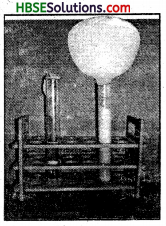
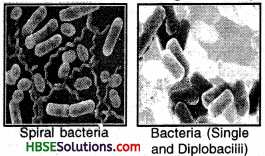
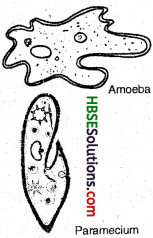
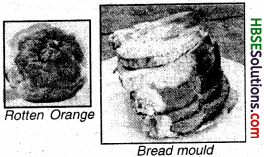


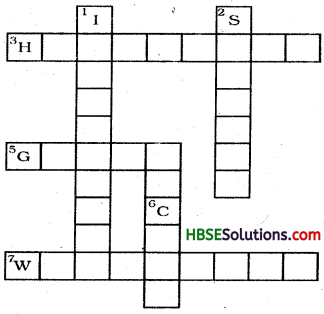
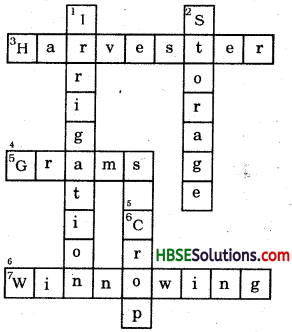
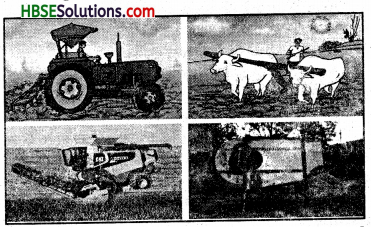
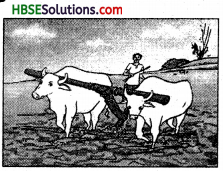


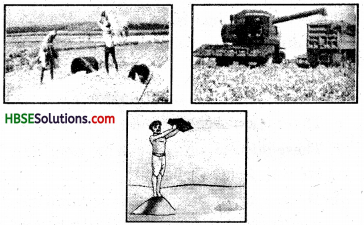
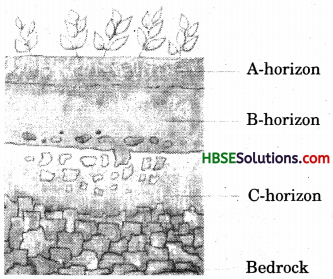 Soil profile
Soil profile